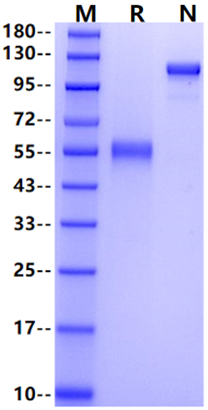Ala27-Pro167, with C-terminal Human IgG Fc ASKAPVCQEITVPMCRGIGYNLTHMPNQFNHDTQDEAGLEVHQFWPLVEIQCSPDLRFFLCSMYTPICLPDYHKPLPPCRSVCERAKAGCSPLMRQYGFAWPERMSCDRLPVLGRDAEVLCMDYNRSEATTAPPRPFPAKPIEGRMDPKSSDKTHTCPPCPAPELLGGPSVFLFPPKPKDTLMISRTPEVTCVVVDVSHEDPEVKFNWYVDGVEVHNAKTKPREEQYNSTYRVVSVLTVLHQDWLNGKEYKCKVSNKALPAPIEKTISKAKGQPREPQVYTLPPSRDELTKNQVSLTCLVKGFYPSDIAVEWESNGQPENNYKTTPPVLDSDGSFFLYSKLTVDKSRWQQGNVFSCSVMHEALHNHYTQKSLSLSPGK
1. Sun Y. et al. (2020) FZD5 contributes to TNBC proliferation, DNA damage repair and stemness. Cell Death and Disease. 11: 1060.1/2
FZD5, a member in Frizzled family, was identified to be preferentially expressed in TNBC (triple-negative breast cancer), and associated with unfavorable prognosis. Loss and gain of function studies revealed that FZD5 contributed to TNBC cell G1/S transition, DNA replication, DNA damage repair, survival, and stemness. Mechanistically, transcription factor FOXM1, which promoted BRCA1 and BIRC5 transcription, acted as a downstream effecter of FZD5 signaling. FOXM1 overexpression in FZD5-deficient/low TNBC cells induced FZD5-associated phenotype. Finally, Wnt7B, a specific ligand for FZD5, was shown to be involved in cell proliferation, DNA damage repair, and stemness. Taken together, FZD5 is a novel target for the development of therapeutic strategies to overcome chemoresistance and prevent recurrence in TNBC.

1μg (R: reducing conditions, N: non-reducing conditions).